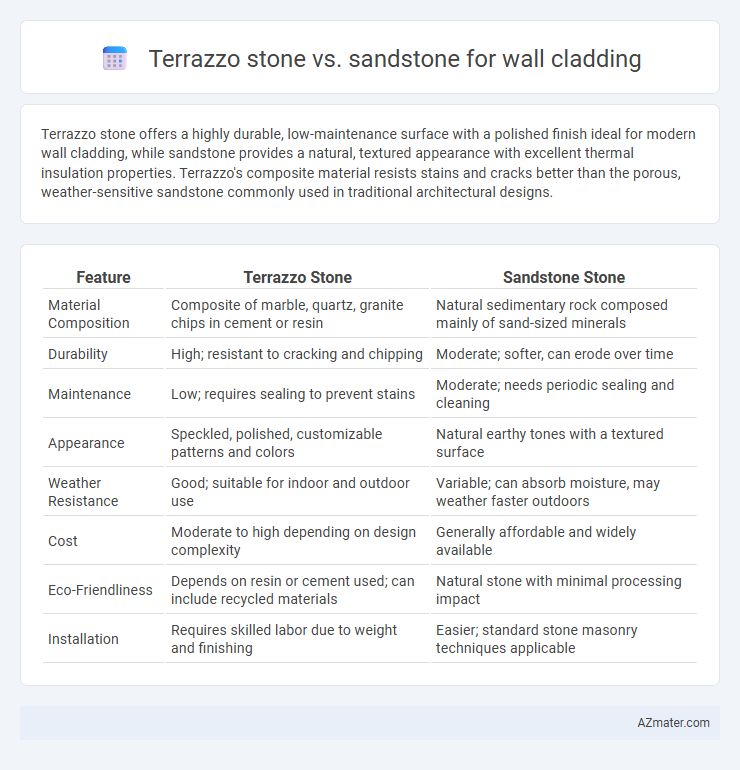Terrazzo stone offers a highly durable, low-maintenance surface with a polished finish ideal for modern wall cladding, while sandstone provides a natural, textured appearance with excellent thermal insulation properties. Terrazzo's composite material resists stains and cracks better than the porous, weather-sensitive sandstone commonly used in traditional architectural designs.
Table of Comparison
| Feature | Terrazzo Stone | Sandstone Stone |
|---|---|---|
| Material Composition | Composite of marble, quartz, granite chips in cement or resin | Natural sedimentary rock composed mainly of sand-sized minerals |
| Durability | High; resistant to cracking and chipping | Moderate; softer, can erode over time |
| Maintenance | Low; requires sealing to prevent stains | Moderate; needs periodic sealing and cleaning |
| Appearance | Speckled, polished, customizable patterns and colors | Natural earthy tones with a textured surface |
| Weather Resistance | Good; suitable for indoor and outdoor use | Variable; can absorb moisture, may weather faster outdoors |
| Cost | Moderate to high depending on design complexity | Generally affordable and widely available |
| Eco-Friendliness | Depends on resin or cement used; can include recycled materials | Natural stone with minimal processing impact |
| Installation | Requires skilled labor due to weight and finishing | Easier; standard stone masonry techniques applicable |
Introduction to Wall Cladding Materials
Terrazzo stone offers a durable and visually striking option for wall cladding, combining chips of marble, quartz, and glass embedded in a cement or epoxy base for a smooth, polished finish. Sandstone wall cladding provides a natural, earthy texture with excellent weather resistance, making it ideal for both interior and exterior applications. The choice between terrazzo and sandstone depends on desired aesthetic, maintenance requirements, and environmental conditions.
Understanding Terrazzo Stone: Composition and Features
Terrazzo stone for wall cladding is a composite material composed of marble, quartz, granite, or glass chips embedded in a cement or resin binder, offering high durability and a smooth, polished surface. Its unique speckled appearance allows for versatile design options compared to the naturally grainy and textured look of sandstone. Terrazzo provides superior resistance to stains and moisture, making it ideal for both indoor and outdoor applications where longevity and aesthetics are essential.
Exploring Sandstone Stone: Characteristics and Appeal
Sandstone stone boasts exceptional durability and natural beauty, making it a preferred choice for wall cladding in various architectural styles. Its distinct grainy texture and warm earthy tones create a visually appealing, rustic ambiance while offering excellent resistance to weathering and erosion. Sandstone's versatility allows seamless integration into both traditional and modern interiors, enhancing aesthetic appeal and structural integrity.
Aesthetic Differences: Terrazzo vs Sandstone Cladding
Terrazzo wall cladding offers a polished, colorful, and speckled appearance due to its composite of marble, quartz, and glass chips embedded in concrete or resin, creating a modern and vibrant aesthetic. Sandstone cladding provides a natural, earthy texture with warm, muted tones that highlight organic patterns and grains, lending a rustic and timeless charm to walls. The glossy finish of terrazzo contrasts sharply with the matte, rugged surface of sandstone, making each ideal for distinct architectural styles and interior design preferences.
Durability and Longevity Comparison
Terrazzo stone exhibits superior durability and longevity for wall cladding compared to sandstone due to its composite nature of marble, quartz, and cement, providing high resistance to impact and weathering. Sandstone, being a sedimentary rock, is more porous and prone to erosion, making it less durable in harsh environmental conditions. Terrazzo's low maintenance and resistance to chipping and staining make it a more long-lasting choice for exterior and interior wall cladding applications.
Maintenance and Cleaning Requirements
Terrazzo stone requires minimal maintenance due to its dense, non-porous surface, which resists stains and moisture, making cleaning simple with neutral pH cleaners. Sandstone, being porous and softer, demands regular sealing and careful cleaning to prevent absorption of dirt and water damage, necessitating specialized stone cleaners. Both materials benefit from routine dusting, but sandstone's higher porosity increases its susceptibility to weathering and requires more vigilant maintenance.
Installation Process: Terrazzo vs Sandstone
Terrazzo stone requires a precise and skilled installation process involving pouring or setting pre-cast panels, followed by grinding and polishing to achieve a smooth, durable surface ideal for wall cladding. Sandstone stone installation involves cutting, shaping, and securely adhering heavier natural stone slabs or tiles, often requiring specialized anchoring systems due to its porous nature and natural textures. Terrazzo's installation demands more surface preparation and finishing labor, whereas sandstone focuses on mechanical fixing and weatherproofing measures to ensure longevity on exterior or interior walls.
Environmental Impact and Sustainability
Terrazzo stone for wall cladding offers high sustainability through its use of recycled materials such as glass and marble chips, reducing waste and lowering environmental footprint compared to natural sandstone. Sandstone, while natural and biodegradable, often involves energy-intensive quarrying processes that contribute to habitat disruption and higher carbon emissions. Choosing terrazzo promotes circular economy principles with minimal resource depletion, whereas sandstone's environmental impact varies depending on extraction practices and sourcing.
Cost Implications for Wall Cladding
Terrazzo stone generally incurs higher initial costs for wall cladding compared to sandstone due to its composite materials and labor-intensive installation process. Sandstone offers a more budget-friendly option with natural durability and easier workability, reducing both material and labor expenses. Long-term maintenance of terrazzo can be cost-effective given its resistance to stains and wear, while sandstone may require periodic sealing and repairs, impacting overall cost efficiency.
Best Applications and Design Recommendations
Terrazzo stone offers exceptional durability and vibrant color customization, making it ideal for high-traffic indoor walls and modern commercial spaces where design flexibility and easy maintenance are priorities. Sandstone stone provides a natural, warm aesthetic with excellent weather resistance, better suited for exterior wall cladding, garden walls, and rustic architectural styles that benefit from its textured, earthy appearance. Combining terrazzo's sleek, polished finish with sandstone's organic feel can create striking contrast designs in transitional interior-exterior projects.

Infographic: Terrazzo stone vs Sandstone stone for Wall Cladding
 azmater.com
azmater.com